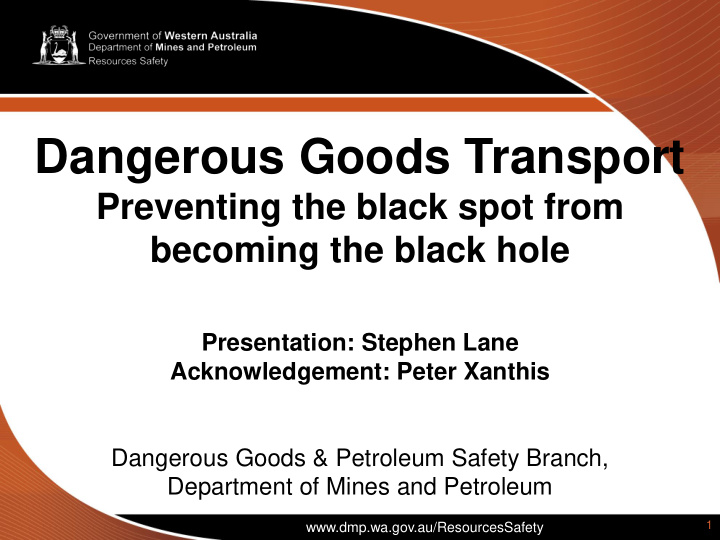



Dangerous Goods Transport Preventing the black spot from becoming the black hole Presentation: Stephen Lane Acknowledgement: Peter Xanthis Dangerous Goods & Petroleum Safety Branch, Department of Mines and Petroleum 1 www.dmp.wa.gov.au/ResourcesSafety www.dmp.wa.gov.au/ResourcesSafety
Introducing dangerous goods safety • Storage, handling, manufacture • Transport (road and rail) • Explosives • Security sensitive ammonium nitrate • Major hazard facilities 2 www.dmp.wa.gov.au/ResourcesSafety
Dangerous goods 3 www.dmp.wa.gov.au/ResourcesSafety
A day in the life of a Dangerous Goods Officer… On road enforcement Cylinder filling MPU inspections Tanker transfer 4 www.dmp.wa.gov.au/ResourcesSafety
Black spot 5 www.dmp.wa.gov.au/ResourcesSafety
Crash 6 www.dmp.wa.gov.au/ResourcesSafety
Case study – vehicle ANE triple road train similar to photo – Great Northern Highway (Meekatharra) 7 www.dmp.wa.gov.au/ResourcesSafety
Case study – environment Fine weather – dusk 8 www.dmp.wa.gov.au/ResourcesSafety
Right hand curve in road 9 www.dmp.wa.gov.au/ResourcesSafety
Case study – driver Driver: Driven 12 hours Driver: Driven 12 hours Last rest break: 30 minutes earlier Last rest break 30 minutes earlier 10 www.dmp.wa.gov.au/ResourcesSafety
Swerved left to avoid oncoming road train that didn’t stop 11 www.dmp.wa.gov.au/ResourcesSafety
Actual accident scene 12 www.dmp.wa.gov.au/ResourcesSafety
13 www.dmp.wa.gov.au/ResourcesSafety
14 www.dmp.wa.gov.au/ResourcesSafety
Actual submitted report to DMP 15 www.dmp.wa.gov.au/ResourcesSafety
Transfer Situation: • Road conditions blamed for accident, yet decant in same spot with road still open and no restrictions? • Great Northern Highway has AN, NaCN, explosives, corrosives, xanthates and diesel tankers • Double, triples and quad combinations operating Controls: • Warning signs? • Speed restrictions? • Emergency Services? • Drag tanker from roadside? • Risk assessment? 16 www.dmp.wa.gov.au/ResourcesSafety
What if this had happened? 17 www.dmp.wa.gov.au/ResourcesSafety
Risks What is As Low As Reasonably Practicable (ALARP) for transporting dangerous goods? How do you assess risk of transporting ammonium nitrate emulsion in a road train passing through local town with schools and a hospital? 18 www.dmp.wa.gov.au/ResourcesSafety
Acceptance of Risk How does your company accept the risk of: • transporting goods A/B/C in approved packagings X/Y/Z, • from consignors Curly, Dodgy and Rusty, • overpacked as per Procedure P1/2/3, • consolidated by Loaders Dick & Harry into Freight Container 1 • with other Portable Tanks PT1 & PT2 • in a triple-trailer configuration driven by Safety Samantha • over a specific pre-determined route • to consignees Mining Magnate & Hardwares R US? 19 www.dmp.wa.gov.au/ResourcesSafety
Levels of risk assessment • Qualitative treatment of each aspect of your transport system • Quantitative risk assessment for specific dangerous goods on specific routes • Hazard ID and control • HAZOP for tanker transfers, unloading and loading 20 www.dmp.wa.gov.au/ResourcesSafety
Using Appropriate Risk Assessment Tools • Abundance of Risk Management principle guidelines that align with OSH standards, AS31000 • ISO 39001:2012 Road traffic safety (RTS) management system – apply to your depot/ warehouse • Paucity of relevant and user-friendly templates for assessing hazards involved in DG transport activities. 21 www.dmp.wa.gov.au/ResourcesSafety
DMP Approach to DG Transport Risk Assessment • Physical hazards - containers and mechanical handling • Chemical hazards inherent in DG • Consolidating DG loads • Loading DG • Treating Defective Packaging • Load Restraint • In-transit procedures • Activating Transport Emergency Response Plan • Unloading DG to Consignee premises 22 www.dmp.wa.gov.au/ResourcesSafety
Document on USB. Feedback and amendments welcomed. 23 www.dmp.wa.gov.au/ResourcesSafety
24 www.dmp.wa.gov.au/ResourcesSafety
Consolidating Dangerous Goods Loads Consignment Issues • Transport consignment form does not include DG declaration consignor offering DG as general freight • Consignment system does not recognise UN No. or DG Classes no information for transport documentation, segregation or placarding Overpacking • Overpacking technique with black shrink-wrap obscures incompatible goods segregation issues 25 www.dmp.wa.gov.au/ResourcesSafety
Loading Dangerous Goods Loading Plan • No documented load plan means pallets loaded according to consignee location poorly planned loads • Load plan does not indicate position of DG classes on combination poor knowledge of load by company driver or sub-contractor picking up loaded trailers Achieving Effective Segregation Effective Placarding (incl. IBC Emergency Information Panels) 26 www.dmp.wa.gov.au/ResourcesSafety
Load Restraint Procedural issues • Principles of Load Restraint Guide 2004 not formally adopted Generic hazards to address Pallets of packages IBCs • Flexible IBCs are creased significantly due to solids moving internally gradual loosening of strap in-transit Stillages & Cylinders • Stillages without lockdown mechanism on base or vehicle locating pins unstable loads Placardable Units – Twist Locks 27 www.dmp.wa.gov.au/ResourcesSafety
Defective Packaging Identifying non-UN Packaging • Approved packaging marking specifications not audited by staff accepting non-approved & non-rated outer packaging Identifying defective/ damaged/ leaking package Managing receivals Dealing with handling incidents • Mechanical handling incidents create damage or leakage extra handling work and isolating products • Overdrums or Segregation Packaging unavailable means direct waste management or product return not possible Responding to “in -transit ” situations 28 www.dmp.wa.gov.au/ResourcesSafety
Determining risk How do you determine if the risk is: • Negligible, Low, Medium, High, Extreme • Acceptable or unacceptable to your company? • Controlled or mitigated? 29 www.dmp.wa.gov.au/ResourcesSafety
Reviewing risk What determines a review of your risk assessment? • New Dangerous Good for a consignor? • New packaging for Dangerous Goods? • New consignee location (new premises) • Incidents affecting container or vehicle integrity? • Incident that injured your employee? • Time? 30 www.dmp.wa.gov.au/ResourcesSafety
Know your load • More than placarding! • Transport document and emergency procedure guide • Empty, full and non-DG containers • Load plan 31 www.dmp.wa.gov.au/ResourcesSafety
Recognise the Hazard FLAMMABLE OXIDIZING LIQUID AGENT 5.1 3 32 www.dmp.wa.gov.au/ResourcesSafety
Understanding emergency response • Transport emergency response plan • Responsibilities under regulations • Credible scenarios ─ vehicle accident ─ vehicle rollover ─ transfer problem ─ leaking packages 33 www.dmp.wa.gov.au/ResourcesSafety
Self-audit tool for prime contractors (six pillars) 34 www.dmp.wa.gov.au/ResourcesSafety
Audit summary of corrective actions What would a lead auditor from DMP report after examining your transport system? 35 www.dmp.wa.gov.au/ResourcesSafety
Continuous improvement of transport system 36 www.dmp.wa.gov.au/ResourcesSafety
Whatever approach you take to confronting risks peculiar to your transport operation, do not let the black spot in your business become an all-absorbing, ever-expanding black hole. 37 www.dmp.wa.gov.au/ResourcesSafety
Questions or comments? 38 www.dmp.wa.gov.au/ResourcesSafety
Recommend
More recommend